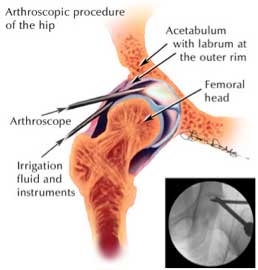Hip Arthroscopy–Complex
 Hip Arthroscopy Complex Surgery refers to the viewing of the interior of the Hip joint through an Arthroscope, and the treatment of the Hip and micro fractures of the hip through a minimally invasive approach. This technique is sometimes used to help in the treatment of various joint disorders has gained popularity because of the small incisions used and shorter recovery times when compared with conventional surgical techniques (sometimes referred to as “open surgery”). Hip Arthroscopy was not feasible until recently, new technology in both the tools used and the ability to distract the hip joint has led to a recent surge in the ability to do Hip Arthroscopy and the popularity of it.
Hip Arthroscopy Complex Surgery refers to the viewing of the interior of the Hip joint through an Arthroscope, and the treatment of the Hip and micro fractures of the hip through a minimally invasive approach. This technique is sometimes used to help in the treatment of various joint disorders has gained popularity because of the small incisions used and shorter recovery times when compared with conventional surgical techniques (sometimes referred to as “open surgery”). Hip Arthroscopy was not feasible until recently, new technology in both the tools used and the ability to distract the hip joint has led to a recent surge in the ability to do Hip Arthroscopy and the popularity of it.
Preparation for Hip Arthroscopy
- Always tell your doctor or nurse what drugs you are taking, even drugs, supplements, or herbs you bought without a prescription.
- During the 2 weeks before your surgery:
- You may be asked to stop taking drugs that make it harder for your blood to clot. These include aspirin, ibuprofen (Advil, Motrin), naproxen (Naprosyn, Aleve), blood thinners such as warfarin (Coumadin), and other drugs.
- Tell your doctor if you have been drinking a lot of alcohol, more than 1 or 2 drinks a day.
- If you smoke, try to stop. Ask your doctor for help. Smoking can slow down wound and bone healing.
On the day of your surgery:
- You will usually be asked not to drink or eat anything for 6 to 12 hours before the procedure.
- Take the drugs your doctor told you to take with a small sip of water.
- Your doctor or nurse will tell you when to arrive at the hospital.
Hip Arthroscopy Complex Surgery
Hip Arthroscopy Complex surgery is done by making small cuts around your hip and looking inside using a tiny camera. Other medical instruments may also be inserted to examine or treat your hip joint.
Description
During Arthroscopy of the Hip, the surgeon uses a tiny camera called an Arthroscope to see inside your hip.
- An Arthroscope is made up of a tiny tube, a lens, and a light source. A small surgical cut is made to insert it into your body.
- The surgeon will look inside your hip joint for damage or disease.
- Other medical instruments may also be inserted through one or two other small surgical cuts. This allows the surgeon to treat or fix certain problems, if needed.
- Your surgeon may remove extra pieces of bone that are loose in your hip joint, or fix cartilage or other tissues that are damaged.
Spinal, epidural, or general anesthesia will be used in most cases. You may also receive medicine to help you relax.
Hip Arthroscopy Complex Recovery
- Whether you fully recover after Hip Arthroscopy depends on what type of problem was treated. If you also have arthritis in your hip, you will still have arthritis symptoms after hip surgery.
- Outlook (PrognosisExpand Section After surgery, you will need to use crutches for 2 to 6 weeks.
- During the first week, you should not place any weight on the side that had surgery.
- You will slowly be allowed to place more and more weight on the hip that had surgery after the first week.
- Your surgeon will tell you when it is OK to return to work. Most people can go back to work within 1 to 2 weeks if they are able to sit most of the time.
- You will be referred to physical therapy to begin an exercise program.
Risks
The risks for any anesthesia are:
- Allergic reactions to medicines
- Breathing problems
The risks for any surgery are:
- Bleeding
- Infection
Other risks from this surgery include:
- Bleeding into the hip joint
- Damage to the cartilage or ligaments in the hip
- Blood clot in the leg
- Injury to a blood vessel or nerve
- Infection in the hip joint
- Hip stiffness
